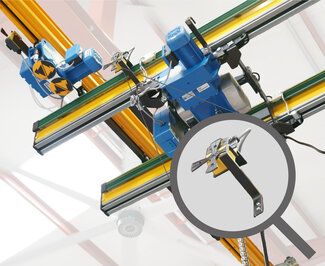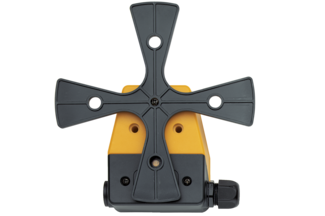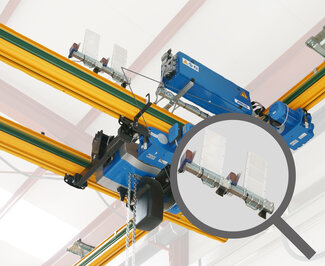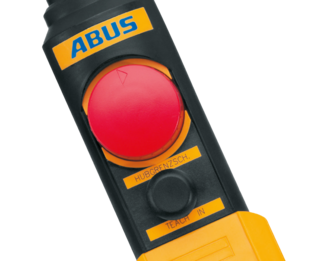Motion restrictors for suspended rails
Motion restrictor for the trolley travel drive (crosswise)
- Deliverable for all suspended rails in conjunction with an electric drive for the movement of hoists (included in the standard scope of delivery for radio remote controls)
Motion restrictor for the drive of the crane travel (longitudinal)
- Braking function to the slow crane speed before reaching the end of the beam. The opposite travel movement is possible with a faster crane speed
- In addition to the braking function to low speed, there can be a subsequent shut down before reaching the end of the beam. The opposite travel movement at high speed is possible.
- A contactor control is necessary as an additional piece of equipment.
- Deliverable for all suspended cranes in conjunction with an electric drive for the crane movement (included in the standard scope of delivery for radio remote controls)
Photoelectronic anti-collision device for adjacent cranes
- If more than one crane with an electronic drive travels on one track, we recommend a photoelectronic anti-collision device. This increases safety to ensure that two cranes do not inadvertently collide.
- The anti-collision device can consist of two switching stages: A braking function to low crane speed before reaching another crane on the same track. The opposite travel movement at high speed is possible.
- In addition to the braking function to low speed, there can also be a subsequent shut-down before reaching the adjacent crane. The opposite travel movement at high speed is possible.
- A contactor control is necessary as an additional piece of equipment
- The switching distance can be flexibly adjusted. The distance between the cranes can be up to 20 metres
-
Deliverable for all suspended cranes in conjunction with an electric drive for the crane movement (included in the standard scope of delivery for several main girders and the use of radio remote controls)
Bypass control for drives of the trolley travel (crosswise) and the crane travel (longitudinal)
- If obstacles in the building restrict crane operation, these must be bypassed. A bypass control monitors and supports this process.
- In the area of the crane travel movement and the trolley travel movement, there are defined areas in which the continuation of the travel movement is not possible (shut-down). These areas must always be bypassed with the other travel movement. The opposite travel movement can be performed at high speed.
- Operators who have been specially authorized can be provided with a (lockable) switch on the control unit for bypassing the bypass control system. This function can also be restricted to low speed only.
- A contactor control is necessary as an additional piece of equipment.
- Deliverable for all suspended cranes in conjunction with electric drives for the crane and trolley movement
Electronic hoist limiter
- Hoist limit switch is possible for all suspended rail systems




